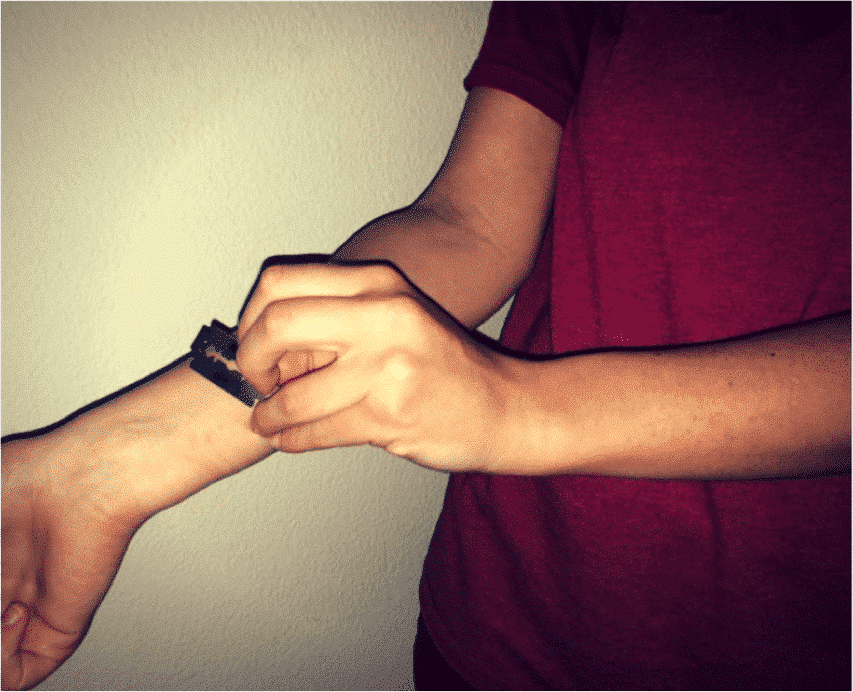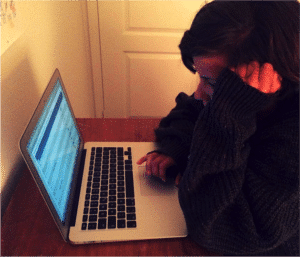
Pia was 13-years-old when she cut herself for the first time. She was confused, lonely, and hopeless. Self-harm provided a distraction from her emotional pain and anchored her to her physicality amongst the numbness. She started with a tiny cut, ultimately inflicting deeper and deeper cuts. Even the hours anticipating cutting brought her comfort. She found a community of cutters on an online forum who provided support and caring while also encouraging more dangerous behaviors. She wasn’t alone with her shameful secret. But she wasn’t stopping either … Could your child end up like Pia?
Cutting
Cutting refers to self-harming practice distinct from a suicide attempt. Cutters typically make small superficial cuts on their arms, legs, or parts of the body easily concealable by clothing. Cutting distracts the individual from emotional pain, releases endorphins which may trigger a mood boost, and is often a cry for help rather than an intent to inflict lethal harm (Davis, 2005).
Dr. Bennett often treats teens and adults who self harm. I’ve also seen several cutting incidents working as a paramedic. Because the cutting ritual can take on profound meaning, some injuries are uncomfortably creative. For instance, I’ve seen kids cut shapes, patterns, words, and even sentences into their skin. When I interviewed Pia for this article, she showed me her first “masterpiece,” the word “HATE” cut into her right thigh.
Why cut?
Pia: “I remember a painful time in my childhood when my dad didn’t come home at night. My mom told me he had troubles at work, and that I shouldn’t be worried. But then it started to become a habit, and my dad would be gone most days of the week. I was really attached to him. I missed having a male role model and friend who could tell me what to do when there seemed to be no way out for me. When my parents got a divorce my world fell apart. I felt lonely, hopeless, sad, and misunderstood. I withdrew more and more, lost most of my friends, and started to become depressed. Since I wasn’t able to soothe my emotional pain on my own, I looked for answers online. That was when I found out about cutting.”
***
The most common reasons teens give for cutting are that they’re trying to make themselves “feel alive” instead of the numbness, or they’re trying to distract themselves from intense or overwhelming emotions such as anger or hurt (McCoy, 2009).
***
That was true for Pia. She wanted to have the control and power of harnessing pain whenever she wanted. She said that sometimes when she woke up in the morning, she felt nothing but emptiness. Cutting helped her “feel” her body again rather than just feeling intense emotional pain.
The controversial Netflix show 13 Reasons Why addresses self-harming behavior, with the main character ultimately committing suicide, leaving behind her audio-recorded 13 reasons “why”. The show was a huge success, with children of all ages binge-watching it over spring break without their parents’ consent. I wondered, if this show could be a danger to teens already on the edge?
During an interview for I-heart radio, Dr. Bennett referred to the show and stated that a majority of people have suicidal fantasies at one time or another. She suggested that 13 Reasons Why could trigger vulnerable teens. She lectured in our psychology class that she has seen self-harming behavior be quite contagious in schools and inpatient treatment settings, spreading from teen to teen quickly. Now the Internet is a source of cutting contagion.
Who cuts, and how common is it?
Cutting is a fairly common practice in the United States. There are about two million cases reported annually with approximately 15% of teens reporting some form of self-injury. Studies show an even higher risk for self-injury among college students, with rates ranging from 17%-35% (Mental Health America, 2013). One in five females and one in seven males have engaged in self-injury practices (Gluck, 2016). Ninety percent of people who engage in self-harming techniques start during their teen or pre-adolescent years (Gluck, 2016).

Did the Internet contribute to Pia’s cutting?
Pia: “I remember sitting at my desk. I was supposed to do homework but instead I Googled “how to deal with emotional pain.” Somehow I stumbled on a few websites which mentioned cutting. Pretty soon I was hooked, researching for hours and eventually finding a useful tutorial how to start my first cut.”
Experts say the Internet is the main contributor for teens to not only find out about the various methods of cutting but also to demonstrate or even glorify self-injury (Steinberg, 2014). Forums like “The Cutting-Board” encourage kids to share their concerns and questions about cutting and find useful expertise. Tips and tricks about how to hide their cuts, what do to if someone gets suspicious, or advice when cutting-goes wrong are popular posts. Furthermore, there are several YouTube tutorials of “how to cover up your scars after cutting,” like a video by 14-year-old Julia Ansell.
How to recognize that your child is cutting
Concealing clothes
If your child suddenly starts wearing long sleeves even during hot days, this could be a sign that she is hiding injuries or scars.
Behavioral changes
Social anxiety, depression, and low self-esteem are often comorbid with cutting (Davis, 2005). If your child starts isolating, eating more or eating less, sleeping more, acts lethargic, isn’t interested in his usual interests, or acts sad or irritable, keep an eye out for self mutilation practices.
Spending time browsing for information about self harm and visits on online forums
Kids often use secret terminology to hide their online activities from parents. Hashtag terms like #sue (a synonym for suicidal) or #secretsociety123 are popular code words to discreetly form online communities discussing self-harm (Yandoli, 2014). Sometimes pictures with these hashtags overlap with other self-harming techniques or mental disorders like anorexia (#ana) or depression (#deb).
Possession of cutting tools
Keep an eye out for sharp objects that may be used for cutting, piercing, or burning like razor blades, knives, paper clips, broken glass, scissors, needles, or lighters.
Cuts, bruises, burns, or scars
Kids will occasionally change methods or location if they fear detection. Escalation is rare but can become an issue. Dr. Bennett has treated clients with comorbid mental illness that went as far as breaking joints with a ball ping hammer or engaging in oddly ritualistic mutilation like the practice of suspension (piercing the skin with hooks and hanging from them).
What you can do for your child?
Be empathetic and sensitive
If you see evidence of intentional injury, ask about it in a straightforward, emotionally neutral manner. Of course share your concern, but be careful not to escalate the situation by panicking, threatening, or lecturing.
Be supportive and present for your child
Let your child know he or she can always come to you with any troubles, issues or concerns. Make yourself available and willing to talk when your child approaches, on her terms. Kids often avoid talking to their parents, because they’re afraid that they’ll lose their trust or add an additional stress factor to an already stressful situation, like going through a divorce or financial issues (Steinberg, 2014).
Express your emotions
Be authentic and present. Not only does this model appropriate communication strategies, but your child will recognize that he is loved and important. Tell him that you can get through this together.
Seek help and treatment
Cutting is often an expression of distress from mental disorders, like depression or anxiety. Consult a clinical psychologist who has specialized training with self harm behaviors. Not only can a clinician work with your child to achieve insight and build resilience by teaching emotional coping skills, but she can also provide much needed consult and support for family members. Often times kids will accept influence from a therapist even when they are dismissive of parenting support.

I’m the mom psychologist who will help you GetKidsInternetSafe.
Onward to More Awesome Parenting,
Tracy S. Bennett, Ph.D.
Mom, Clinical Psychologist, CSUCI Adjunct Faculty
GetKidsInternetSafe.com
*Due to professional discretion, Pia is a fictional name.
Works Cited
Davis, J.L. (2005). Cutting and Self-Harm: Warning Signs and Treatment. WebMD, Retrieved April 23rd, 2017 from: http://www.webmd.com/mental-health/features/cutting-self-harm-signs-treatment#1
Gluck, S. (2016). Self Injury, Self Harm Statistics and Facts. Healthy Place, retrieved April 24th, 2017 from: https://www.healthyplace.com/abuse/self-injury/self-injury-self-harm-statistics-and-facts/
McCoy, K. (2009). When Teenagers Cut Themselves. Everyday Health, retrieved April 23rd, 2017 from: http://www.everydayhealth.com/kids-health/when-teens-cut-themseleves.aspx
Steinberg, S., (2014). What to Do If Your Child Is Cutting. US News, retrieved April 24th, 2017 from: http://health.usnews.com/health-news/health-wellness/articles/2014/02/28/what-to-do-if-your-child-is-cutting
Krystie Lee Yandoli (2014). Inside The Secret World Of Teen Suicide Hashtags. For buzzfeed, retrieved April 30th, 2017 from https://www.buzzfeed.com/krystieyandoli/how-teens-are-using-social-media-to-talk-about-suicide?utm_term=.jtRrkE8Q9#.kpAzK8oX6
Photo Credits
Girl with a Razorblade, 2016 CC0 1.0
Girl on the Laptop, 2016 CC0 1.0
Don't worry, we will never spam you.









